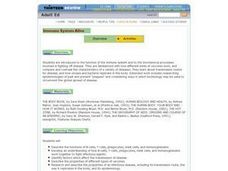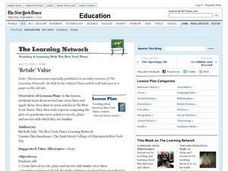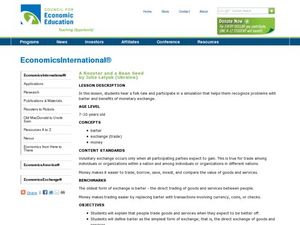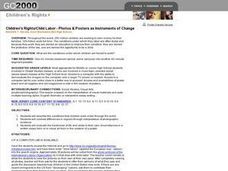Curated OER
What is an Organism?
Sixth graders take a pre-test and summarize teacher's discussion of cells, tissues, organs in their notebooks. They read selections on organisms in their textbook and perform a dissection of a chicken drumstick with the thigh attached....
Curated OER
Window Into Another Culture
Learners read "A Single Lucid Moment" as a class. In groups, they identify the aspects of the United States that might allow for homelessness to happen and compare it with the culture of New Guinea. They write a journal entry about how...
Curated OER
Ethics and Philanthropy The Act of Sharing and Giving
Students define ethics, and identify ways that they have practiced philanthropy in their own family. They listen to a book, write an essay, and identify a role model for philanthropy.
Curated OER
Immune System Alive
Young scholars examine the function of the immune system. They read and discuss text, complete a K-W-L chart, sequence photos of white blood cells encountering bacteria, develop an outline, and write an essay.
Curated OER
Underground Rails: The New York City Subway System
Pupils explore the New York Subway system. They investigate its usefulness as mode of transportation for the people in the city and study its history compared to other city subway systems. They examine how the subway connects the various...
Curated OER
Exploring Cultural Rituals
Learners analyze images and music of common rituals in America with those of other countries. They use worksheets to compare and contrast the events.
Curated OER
The Fight for Human Rights
Students explore the concept of human rights by developing and defending their own 'Bills of Human Rights' and by writing a reflective essay that compares their notions of human rights and the protection of them.
Curated OER
"Retale" Value: Exploring Plot Similarities in Fiction and Nonfiction Stories
Students explore seven basic story lines and apply these story lines to news articles in the New York Times. They write reports comparing the plot of a news article to novels, plays and movies with which they are familiar.
Curated OER
In a Galaxy Far, Far, Far Away
Sixth graders compare distances between objects in the solar system. They investigate how light years are measured and when using them to measure how distances compare with one another. They write an essay exploring the possibility of...
Curated OER
Feudalism and the Magna Carta
Students compare the Magna Carta and the Bill of Rights. In this historical comparison lesson, students examine primary sources of three significant historical documents. Students create a chart in a compare and contrast format, then...
Curated OER
Fiction vs. Nonfiction
Learners explore fiction and nonfiction writing. They identify the elements of fiction in a short story and identify the criteria necessary in a nonfiction piece. Students distinguish the author's purpose in an expository text,...
Curated OER
Independence Masks
Pupils explore how art reflects the economic, political, social, religious and historical concerns of a culture. They research a former colony to determine if there is any history of a mask. Students create a mask representing the...
Curated OER
Fictional Hereos
Students are introduced to the definition of a hero. As a class, they compare and contrast the difference between non-fictional and fictional hereos they have read about. They read a story, create a story map of one of the heroes and...
Curated OER
Chinese Dynasties
Pupils explore several Chinese dynasties and research various topics including papermaking, calligraphy, and Lu Hou. They also demonstrate how to use an abacus and create several math problems to solve with it. Choosing a dynasty,...
Curated OER
Whose Head Goes Here?
Students research the Illinois quarter and the President on it. Students research President Lincoln and American coinage. Students compare this quarter to the other national quarters with Presidents on them.
Curated OER
U.S. History: What Happened Here?
Students apply the global positioning system to create maps of local historical sites. By collaborating with local historical groups, they research events and relate them to broader, national history. In addition to writing essays...
Curated OER
Marriage Equality: Different Strategies for Attaining Equal Rights
Students examine gays rights issues in the United States. For this gay marriage lesson, students investigate how people have made their cases before the executive, legislative, and judicial branches of government to secure their...
Curated OER
Indians and White Americans
In this American history worksheet, students complete a chart comparing 6 aspects of American Indian and White American culture. Students then answer 2 essay questions.
Curated OER
A Rooster and a Bean Seed
Students study exchange and how it has different forms. In this money management lesson, students are able to learn how goods and services work by completing worksheets, activities, essay questions and assessments provided.
Novelinks
The Devil’s Arithmetic: Semantic Feature Analysis
Organize the characters in Jane Yolen's The Devil's Arithmetic according to their shared character traits. After listing character traits as a class, kids note which characters exhibit particular characteristics with a...
Curated OER
Texas History
Students explore the history of Texas. Through researching factual books and folktales, students share their information about Texas. They discuss the Trail of Tears, Davy Crockett, the flags of Texas, and Sam Houston. Students write a...
Curated OER
Spanish/American Comparison
Young scholars compare Spanish and American cultures. In this global studies instructional activity, students review what they have learned in a Spanish culture unit by writing compare and contrast essays about Spanish and American...
Curated OER
Children's Rights/Child Labor - Photos & Posters as Instruments of Change
Middle schoolers research the use of students for labor around the globe. Using magazine pictures, they create a poster showing the various conditions they are subject to. They compare and contrast the differences in regions and...
Curated OER
Geology and it’s Influence
Students compare current geological map and the one from 1800's. In this earth science lesson, students discuss differences between the two and explain the factors that caused the change. They write an essay about how these changes...

























